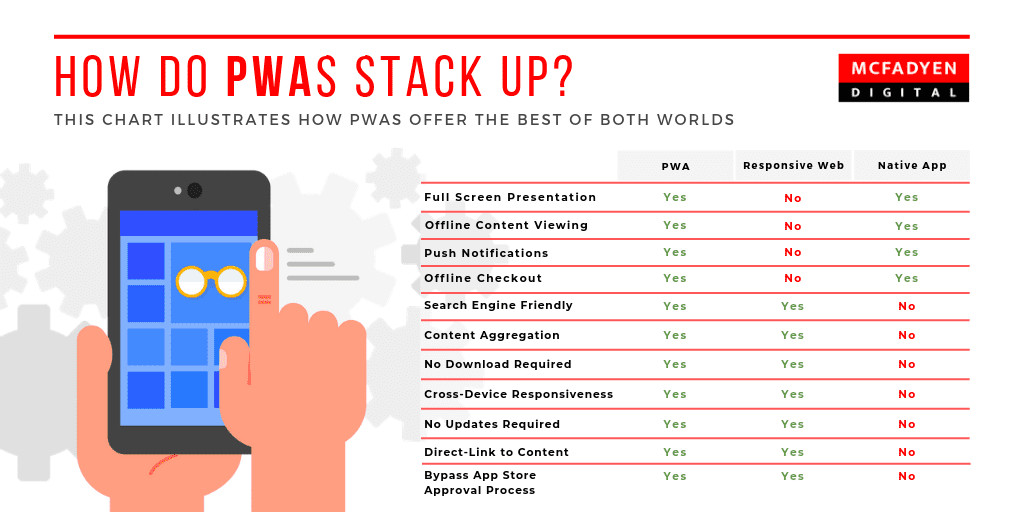
Progressive Web Applications (PWA) are being hailed as the next game changer for the mobile web and as the next big thing for ecommerce. PWA was initially introduced by Google in 2015 and have started to gain huge traction as many of the big brands have started adopting PWA front-ends to their online shops. One of the reasons for the recent spike in adoption is the relative ease of the implementation, given the user experience benefits gained. Both retailers and business-focused online commerce operators are interested in the page-load speed benefits of PWA, the SEO benefits of PWA, but the killer features could end up being things like offline browsing, shopping, and checkout, or app-style push alerts. So far, the industry as a whole is only scratching the surface of what PWAs are capable of.
What is a Progressive Web Application?
When it comes to user experience nothing can beat native apps for speed, native notifications, and smooth, slick user interfaces. These are some areas where even the best mobile-optimized responsive designs still can’t compare to native apps. But even while providing a fantastic user experience, there are some business disadvantages to native apps, mainly in the form of high barrier to adoption and needing significant buy-in from the consumer in order to justify the expense. PWAs can fill this gap by providing a solution that combines best of both worlds. A PWA leverages the latest web technologies to tailor a solution that bridges the gap between a native app and a responsive website while advancing the mobile-first approach.
You can define a PWA as a web site front-end (user interface) that a visitor accesses like a web site, but that behaves like a native app. Such a crossover mashup is made possible by recent advances in browser technology that provide access to native-OS elements such as service workers, local caching, and access to push API’s, mostly driven by Google, but being adopted by Apple, as well. These technologies help PWA provide near app-like experiences like allowing users to put web app icon on their home screen, staying connected to content even when offline, and receiving push notifications, all without installing any kind of app and accessing the PWA via their mobile web browser of choice.

What is driving the growth of the PWA’s?
The short answer is… mobile adoption. We are in the age where consumers live their lives on their mobile device. As per a recent survey of Internet users in the United States, as much as 82% said they used a mobile device to make an online purchase within the past three months. In these times, the real challenge for brands, marketers, and ecommerce operators is about how to think mobile-first. The mobile speed gains, local caching, and app-like features of PWA makes it a brand’s best bet to improve the mobile shopping experience and boost rankings in a mobile-first-obsessed search world.
Are there limitations to PWA?
While PWAs have many “best of both worlds” aspects of apps and mobile web, there are some inherent limitations to be aware of:
1. A PWA can run down battery life faster than a native app because they are authored in JavaScript which can be taxing on the power of the mobile device.
2. Even though PWA can access most of the native OS features, there are still some recent OS features that a PWA still cannot access , such as NFC (near – field communication), Bluetooth, and proximity sensors, among others.
3. PWA has compatibility issues with many older devices and non-updated operating systems.
4. On the performance front, PWA is fast, but still cannot match native app speed. JavaScript is a single- threaded language, which limits performance. For heavier – lifting, bandwidth- intensive tasks, PWA will not be as smooth or powerful as a native app for graphically demanding UI tasks.
5. While Apple allows all updated devices to run PWAs, they still don’t al low access to many key features like Touch ID, FaceID, Beacons, etc.
How do I learn more about Progressive Web Applications?
To understand more about building PWA’s over your current ecommerce platform or for a new property, download our new Ebook – The Definitive Guide to Progressive Web Applications. It has in-depth information on the following:
1. What are the benefits of PWA?
2. How is PWA driving eCommerce growth?
3. What top brands are doing with PWA.
4. The business case for PWA.
5. What is the architecture of a PWA?
6. How to create a PWA using McFadyen’s storefront framework: PWA Shop
McFadyen Digital has helped some of the world’s largest brands deliver innovative Ecommerce and online marketplace solutions to their customers for over thirty one years. Please contact us at info@mcfadyen.com if you’d like to have a conversation about taking your own digital commerce experience to the next level.
Related Articles
Turn Insight Into Impact.
Start Today.





